Patapsco Valley State Park
Home of Besley Family Campsite
The Cradle of Outdoor Recreation in Maryland
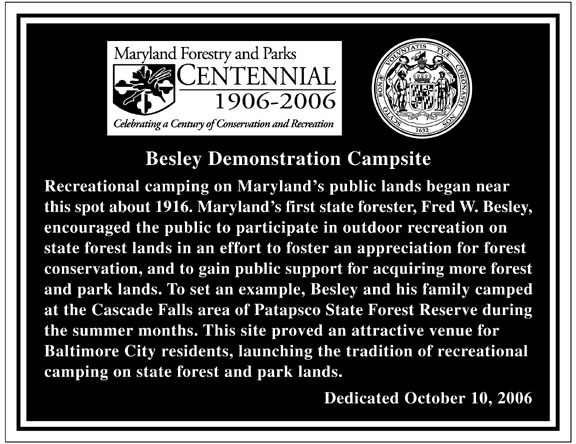
On Tuesday, Oct. 10, 2006 members of the State
Forest and Parks Centennial Committee were joined by many of the volunteer
Friends of Patapsco Valley State Park, DNR State Parks and Forest Service
staff, and interested citizens, including descendents of Maryland's first
State Forester, Fred W. Besley, to dedicate a Centennial Plaque on the
site of the Besley Demonstration Campsite, where outdoor recreation on
Maryland State Forests and Parks originated. Helen Besley Overton, the
granddaughter of Maryland’s first state forester, Fred W. Besley, was an
honored guest.

Pictured at the Besley Family Campsite Plaque Dedication are
(standing left to right): Francis Zumbrun in 1930's Forest Warden uniform,
Maryland Park Service Superintendent Col. Rick Barton, Kirk P. Rodgers, Fred W.
Besley's grandson, Mary Rotz, Peggy Weller, Jane Wright, and John Overington, children of Helen Besley Overington,
and Maryland State Forester Steven W. Koehn. Seated is Helen Besley Overington, youngest daughter of Fred W. Besley.
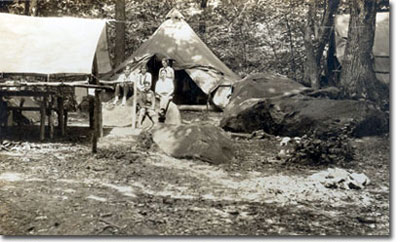
Camp Cascade - The Besley Camp - July 1922
This photo was taken by Fred W Besley in July 1922 (as shown on the back of the photo). It has the number 662 and the title "Camp Cascade Photo, by F.W.B." In the photo, beginning on the right in the back row are Fred Besley's wife, Bertha Besley, and his daughters, Jean Besley and Helen Besley. In the front row on the left is Lowell Besley, his son, and an unknown gentlemam smoking a pipe. This original photo is of very high photographic quality.
Most importantly it will help solve the mystery of the location of this famous campsite which was much discussed at the dedication ceremony held at the Patapsco State Park on October 10, 2006. The relevant plaque which was dedicated on this occasion is shown above.
Dedication of the Plaque Honoring the Besley Campsite
Patapsco State Park October 10, 2006
Kirk P. Rodgers
Marylanders have had a long love affair with the beautiful out of doors of their
state and have long been intrigued by the mystique of wilderness. At the
beginning of the last century our urban peoples began more and more to look for
opportunities to be close to nature, perhaps recalling the happy memories of
times when they or their parents lived in rural areas. But their interactions in
living close to nature by camping out were a bit awkward at first. Some people
thought of camping in tents as something only done by the Army or by people in
dire economic circumstances. They needed convincing. Others didn’t quite know
how to go about it.
Initially some tried to make camping as much as possible like living at home.
According to a July/August 2006 article in the magazine Maryland Life:
“Photographs depict Patapsco State Park campers in 1915 pitching their canvas
tents alongside their pianos and tending to camp fires dressed in suits and
ties”. The Baltimore Sun on October 29, 1916 described camping in Patapsco in
the fall as follows: “They were enjoying watching the change of foliage from
week to week, taking dips in the Patapsco River in spite of the frost, getting
up at 4:00 AM to watch the daybreak, walking 8 miles to church in the morning,
and chopping wood, preparing meals, washing dishes and taking trips throughout
the forest reserve during the day.” Some described this as “roughing it
pleasantly”.
Maryland’s first State Forester had observed this camping enthusiasm here at the
Patapsco and wanted to encourage it. By 1912 he had developed a small recreation
area along the river and by the middle of the decade people were flocking out of
Baltimore to picnic, swim and camp in the park. Camp sites were open to anyone
in the state, provided that they respected “reasonable regulations” (Report of
the Maryland State Board of Forestry 1914/1915). Besley wanted to make it
possible for Marylanders who could not afford to go to Maine or Canada for the
summer to find an outdoor experience closer to home. The Patapsco provided that
opportunity.
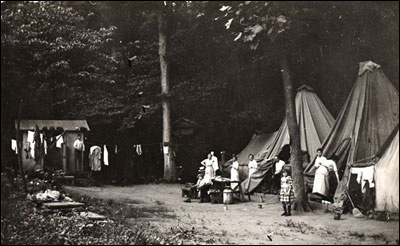 The Baltimore Evening Sun of January 21, 1921 noted: “State Forester Besley is
pushing the Patapsco Forest Reserve as a recreation and camping ground for
Baltimore people … to get as close to Mother Nature as in the wild and
unexplored regions of the North.” The Sun article waxed poetic about Patapsco
camping and I quote: “On the slopes rising up from the river in thick virgin
forest, traversed by springs and streams, ideal camp sites have been staked out.
Some derive their beauty from the view, others from the proximity to the river
and some because they are built right on the edge of a leaping mountain
cascade.” Indeed it was this latter site that Fred Besley chose as the campsite
for his own family and why we are here today. The Sun article noted: “Besley his
wife, and two of their children were spending a month in a camp overlooking the
uppermost rocky basin of one of these lovely cascades.” He added: ” To be
entertained at the Besley camp is a pleasure to long be remembered. Not 10 feet
away from the open air dining tent the water rushes over the rocks of the Upper
Falls. One goes to bed in the big Army tent, with its double decker cot in the
middle and its needle couches on the side, to the sound of the music of the
water and wakes up with it again in the morning.”
The Baltimore Evening Sun of January 21, 1921 noted: “State Forester Besley is
pushing the Patapsco Forest Reserve as a recreation and camping ground for
Baltimore people … to get as close to Mother Nature as in the wild and
unexplored regions of the North.” The Sun article waxed poetic about Patapsco
camping and I quote: “On the slopes rising up from the river in thick virgin
forest, traversed by springs and streams, ideal camp sites have been staked out.
Some derive their beauty from the view, others from the proximity to the river
and some because they are built right on the edge of a leaping mountain
cascade.” Indeed it was this latter site that Fred Besley chose as the campsite
for his own family and why we are here today. The Sun article noted: “Besley his
wife, and two of their children were spending a month in a camp overlooking the
uppermost rocky basin of one of these lovely cascades.” He added: ” To be
entertained at the Besley camp is a pleasure to long be remembered. Not 10 feet
away from the open air dining tent the water rushes over the rocks of the Upper
Falls. One goes to bed in the big Army tent, with its double decker cot in the
middle and its needle couches on the side, to the sound of the music of the
water and wakes up with it again in the morning.”
Clearly the reporter enjoyed camping with the Besley family. One would wish that
he was with us today, but we are even more privileged to have with us a member
of the Besley family who had him as their guest. At my side is Helen Besley
Overington, youngest daughter of Fred Besley. She was 16 years old at the time.
She was 99 on her recent birthday in July. Her life has spanned the entire
century that we celebrate.
A few weeks ago Aunt Holly shared with me some of her memories of camping here
when she was a teenager. If I make a mistake in what I say now, she is here to
correct me. Holly particularly remembers the steep climb up the hill to the
campsite which she often made while carrying large quantities of groceries and
supplies for family and the frequent hungry visitors. She commented that the
food supplies seemed heavier with each step. She also shared with me her
memories of helping here mother up the hill. She said: “Mother was a good sport
about going places despite her arthritis, but she was worried about this climb.
I said I will push you and she said OK.” After this ceremony some of you will
make that same climb. Don’t be embarrassed if you need to give each other a push
or a hand up.
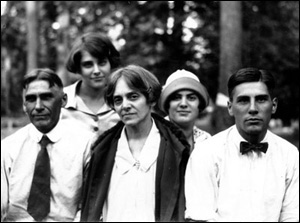 What is the significance of this campsite that we honor today. Holly put her
finger on it last year. She said: “My father was very much in favor of making
recreational use one of the big things that forest reserves offered.” He shared
the view of then Maryland Governor Ritchie who said: ‘’The closer you get to the
people the better it is.” This event today is about people and their love of the
out of doors. And it is about the vision of a man who believed that in promoting
recreational use of forests he would give impetus to his efforts to conserve
forests. And he wanted to demonstrate recreational use in a very practical way,
by camping out with his own family and making his demonstration campsite open to
the public. He was building a constituency. And today more than ever we realize
how powerful that constituency has become. We can honestly say that recreational
use of forest lands in Maryland began here at Patapsco. This is a very special
place in our history and worthy of our celebration this day.
What is the significance of this campsite that we honor today. Holly put her
finger on it last year. She said: “My father was very much in favor of making
recreational use one of the big things that forest reserves offered.” He shared
the view of then Maryland Governor Ritchie who said: ‘’The closer you get to the
people the better it is.” This event today is about people and their love of the
out of doors. And it is about the vision of a man who believed that in promoting
recreational use of forests he would give impetus to his efforts to conserve
forests. And he wanted to demonstrate recreational use in a very practical way,
by camping out with his own family and making his demonstration campsite open to
the public. He was building a constituency. And today more than ever we realize
how powerful that constituency has become. We can honestly say that recreational
use of forest lands in Maryland began here at Patapsco. This is a very special
place in our history and worthy of our celebration this day.
Let me conclude with another quote from the July article in Maryland Life. “Fred
Besley, Maryland’s first State Forester helped to save our forests by promoting
the recreational aspects within. The next time you’re sitting next to a campfire
with your family, raise a smore in his honor.” And raise one to Aunt Holly too!
- Kirk P. Rodgers
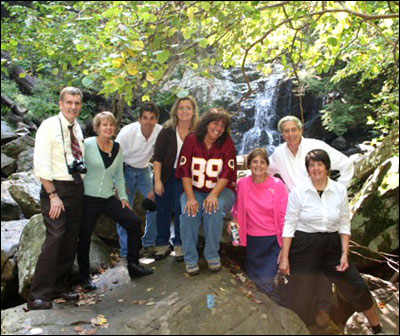
Family members gather after hiking the Cascades trail to
the site of the original Besley Family Demonstration Campsite in Patapsco Valley State Park's
Orange Grove area. Left to right: John Overington, Peggy Weller, Brian
Rodgers, Cathy Rodgers, Kim Rodgers, Mary Rotz, Kirk P. Rodgers and Jane
Wright. Photo courtesy of Francis Zumbrun.
Maryland Was the Third State in America
to Establish a Statewide Forestry Program
Maryland's state parks grew out of the state's early efforts at
forest conservation.
While at first glance conservation of natural resources
and promotion of outdoor recreation may appear to be different objectives,
they in fact go hand-in-hand.
As
a direct result of the Garrett brothers generous and farsighted gift of 2,000
acres of forest land as a State Forest if the State of Maryland
would agree to take care of it, the legislature
passed Maryland's first forestry law. Maryland became the third state in the
union, preceded by Pennsylvania and Wisconsin, to establish a statewide forestry
program when Governor Edwin Warfield
signed this law on April 5, 1906.
The original 1906 Forestry Act authorized the State Board of Forestry to
accept donations of land and “to direct the protection and improvement of (1)
state parks and (2) forest reserves.” Acting upon
the board’s recommendation, Governor Warfield appointed an able young forester
working for the U.S. Forest Service, Fred W. Besley, who would serve as
Maryland’s first State Forester from 1906 until 1942. A Yale School of Forestry
trained protégé of Gifford Pinchot, first U.S. Forester, Besley proved to be an
able and energetic choice.
Besley Advocated Recreation on State Forest Lands
 We can make a strong case that Fred W. Besley was an early advocate
for outdoor recreation on State forest lands. Maryland’s first State Forester,
observed that he could gain more public support for forest conservation by encouraging people to camp in Maryland’s
State Forest Reserves. Besley deserves great credit for establishing both
statewide forest conservation along with a system of parks.
We can make a strong case that Fred W. Besley was an early advocate
for outdoor recreation on State forest lands. Maryland’s first State Forester,
observed that he could gain more public support for forest conservation by encouraging people to camp in Maryland’s
State Forest Reserves. Besley deserves great credit for establishing both
statewide forest conservation along with a system of parks.
Besley
realized almost immediately that one good way to promote the forestry agenda was
to encourage the public to use forest reserves for recreational purposes. In
1907, John Glenn, a resident of Catonsville, donated the beginnings of a second
forest reserve along the Patapsco River near Baltimore. Almost immediately,
Besley saw the opportunity to entice Baltimore area residents to come recreate
in the great out-of-doors, and by 1910 he was informally referring to the
Patapsco Forest Reserve as “Patapsco Park.”
Maryland's First "State Park"
Besley subsequently developed a small recreation area along the river
on the Patapsco Forest Reserve dedicated specifically for public recreational
use. Campers, picnickers and swimmers flocked out of Baltimore to rusticate
alongside the Patapsco River. Thus, the first state-owned campsites and nature trails were
established in the Patapsco Valley in Baltimore County. By 1920s, thousands of people, mostly from Baltimore,
were visiting the Patapsco Forest Reserve anywhere from a day’s visit, to a
six-month stay.
CCC at Patapsco
State Park
During the Depression years of the 1930s,
President Franklin D. Roosevelt's Civilian Conservation Corps (CCC) planted
trees and built trails, picnic areas, campsites and handsome cut-stone pavilions
to improve what had by then become "Patapsco State Park".
Companies 336 and 356 of the Civilian Conservation
Corps were encamped near Lost Lake at Camp Tydings in the Avalon Area. The
CCC built the
stone picnic shelters in Orange Grove and Glen Artney (not visible from the
river). The CCC was also responsible for planting trees in the
river valley to advance the reforestation efforts and reclaim the over-used and
abused land.
This
Civilian Conservation Corps Camp (Camp SP 2) was operational between 1933 and 1942. Following the start of World War II, the CCC
Camp was converted to the nation's first Conscientious Objector Camp.
1941 - Maryland Department of State Forests
and Parks Emerges
As the years passed, Americans acquired more disposable
income and the automobile provided easier access to the farthest corners of
not only Maryland, but also the nation. Besley was still State Forester
in 1941 when the Department left the University of Maryland and became the
Maryland Department of State Forests and Parks. Surely, Mr. Besley supported the
adding of “parks” to the agency’s name.
To accommodate people with increased income and better
access to transportation, the Maryland Department of Forests and Parks,
later named the Department of Natural Resources, expanded the amount of forest and
park land — not only to provide recreation, but also to protect the natural
environment.
Starting in the post war, late 1940s and on into the 1950s, the demand for
outdoor recreation grew at an astronomical rate, and the Avalon Area of Patapsco
State Park was surveyed as the most densely used recreation site in Maryland.
Now a 14,000 acre, 32-mile-long stretch of public land, Patapsco Valley State
Park hosts over a half million visitors a year.
While it is hard assess the economic impact of these first picnickers and
campers, we know that they pioneered outdoor recreation on Maryland public
lands, and laid the foundation for those who enjoy Maryland’s public lands in
this centennial year of our state's forest and park lands.
Maryland State Parks Today
Today, Maryland State Parks attract over 11.5 million
visitors a year, including over 735,000 campers. These visitors engage in a
wide variety of activities including hiking, biking, hunting and fishing to
name a few. Many of these groups play an active role (as volunteers) in
maintaining and preserving the natural environment on Maryland public lands by
helping to patrol and maintain trails.
More importantly, over a million of these visitors
attend interpretive programs, such as the Junior Ranger Program. Like
the first picnickers and campers a century ago, park visitors learn first-hand the value of
environmental conservation. Maryland State Parks generate $15 million in
revenue a year, but more importantly, Maryland’s 2,545 State Park campsites
generate $168.8 million in economic activity and generate over 2,200 jobs a
year.
For a century now, Maryland State Forests and Parks have
played a key role in protecting the environment, providing the public with
outdoor recreation opportunities, and adding to the economic prosperity of the
State of Maryland.
Acknowledgements:
The editor of this article acknowledges the
contributions of Ross Kimmel and Robert Bailey, as well as other anonymous authors who have contributed
to the historical account of the Department of Natural Resources over the years.
Where errors may occur, this editor and Maryland DNR would sincerely appreciate any corrections, clarification or additional
comments from historians, former staff, and family and friends of DNR who
may have a more accurate factual record or photographs to contribute to this
Centennial Note project.